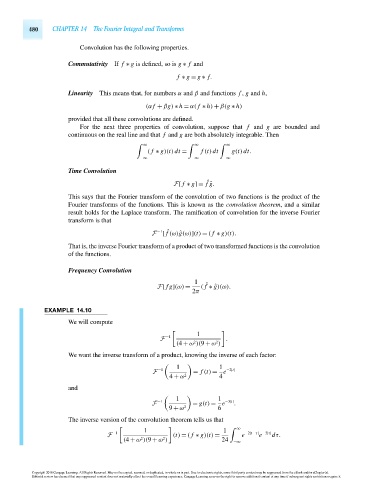Page 500 - Advanced engineering mathematics
P. 500
480 CHAPTER 14 The Fourier Integral and Transforms
Convolution has the following properties.
Commutativity If f ∗ g is defined, so is g ∗ f and
f ∗ g = g ∗ f.
Linearity This means that, for numbers α and β and functions f , g and h,
(αf + βg) ∗ h = α( f ∗ h) + β(g ∗ h)
provided that all these convolutions are defined.
For the next three properties of convolution, suppose that f and g are bounded and
continuous on the real line and that f and g are both absolutely integrable. Then
∞ ∞ ∞
( f ∗ g)(t)dt = f (t)dt g(t)dt.
−∞ −∞ −∞
Time Convolution
F[ f ∗ g]= f ˆg.
ˆ
This says that the Fourier transform of the convolution of two functions is the product of the
Fourier transforms of the functions. This is known as the convolution theorem, and a similar
result holds for the Laplace transform. The ramification of convolution for the inverse Fourier
transform is that
−1
ˆ
F [ f (ω) ˆg(ω)](t) = ( f ∗ g)(t).
That is, the inverse Fourier transform of a product of two transformed functions is the convolution
of the functions.
Frequency Convolution
1
ˆ
F[ fg](ω) = ( f ∗ˆg)(ω).
2π
EXAMPLE 14.10
We will compute
1
−1
F .
2
2
(4 + ω )(9 + ω )
We want the inverse transform of a product, knowing the inverse of each factor:
1 1
−1 −2|t|
F = f (t) = e
4 + ω 2 4
and
1 1
−1 −3|t|
F = g(t) = e .
9 + ω 2 6
The inverse version of the convolution theorem tells us that
∞
1 1
−1
e
F (t) = ( f ∗ g)(t) = e −2|t−τ| −3|τ| dτ.
(4 + ω )(9 + ω ) 24
2
2
−∞
Copyright 2010 Cengage Learning. All Rights Reserved. May not be copied, scanned, or duplicated, in whole or in part. Due to electronic rights, some third party content may be suppressed from the eBook and/or eChapter(s).
Editorial review has deemed that any suppressed content does not materially affect the overall learning experience. Cengage Learning reserves the right to remove additional content at any time if subsequent rights restrictions require it.
October 14, 2010 16:43 THM/NEIL Page-480 27410_14_ch14_p465-504

